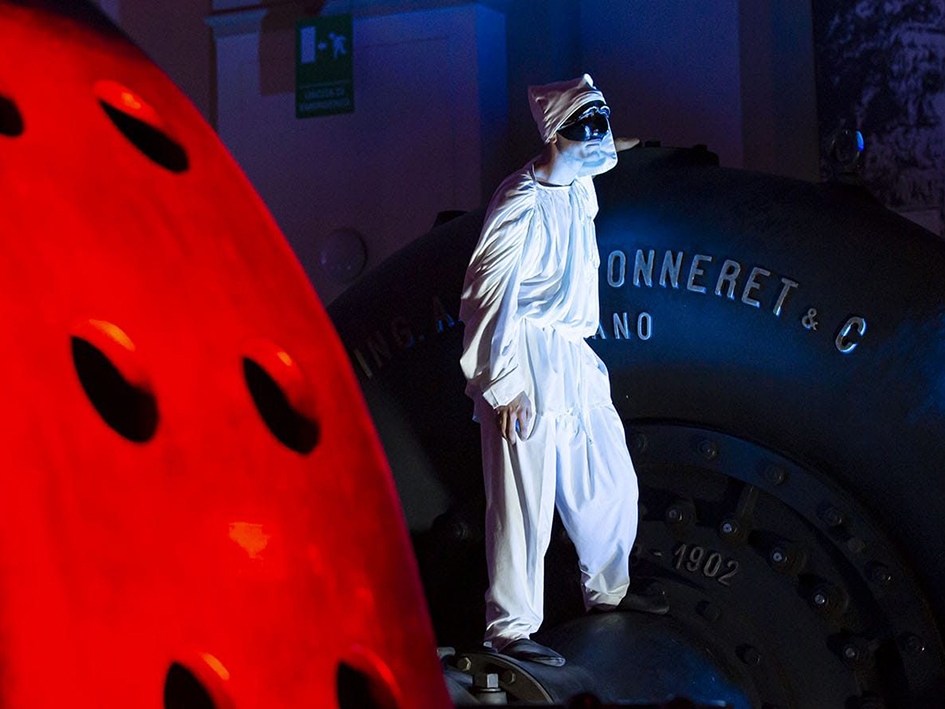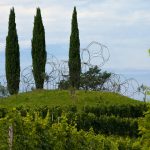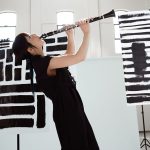Scroll down for the English version
In conversazione con Sabrina Zannier,
curatrice e direttrice di Maravee,
un viaggio lungo vent’anni attraverso aree ex-industriali,
ville storiche, castelli, spazi privati
Riqualificazione, rigenerazione, riutilizzo e riapertura di aree ex industriali, spazi privati, ville storiche e non ultimi i castelli. Luoghi e un approccio che da sempre connotano il tuo lavoro trasferitosi poi quale matrice nei molti progetti curati e diretti. Quale l’idea alla base?
La necessità di portare l’arte e lo spettacolo contemporanei nel quotidiano collettivamente condiviso, perché credo fermamente che il pensiero culturale e la produzione artistica debbano farsi carico di un ruolo sociale votato al welfare e che tale ruolo debba essere riconosciuto in modo trasversale.
Ri-animare luoghi densi di storia attraverso spettacoli e mostre concepiti sulle connotazioni sociali, culturali e industriali, nonché sulle originarie destinazioni d’uso di quei luoghi, significa costruire un consapevole ponte tra il passato e il presente futuribile. Un ponte che ho sempre cercato di animare attraverso la poliedricità dei linguaggi artistici e una messa in scena empatica e coinvolgente. Per raggiungere un pubblico ampio, anch’esso poliedrico, che necessita sia sfatata la “torretta d’avorio” costruita dal sistema dell’arte attorno ai suoi soli protagonisti.
Ri-animare luoghi densi di storia attraverso spettacoli e mostre concepiti sulle connotazioni sociali, culturali e industriali, nonché sulle originarie destinazioni d’uso di quei luoghi, significa costruire un consapevole ponte tra il passato e il presente futuribile
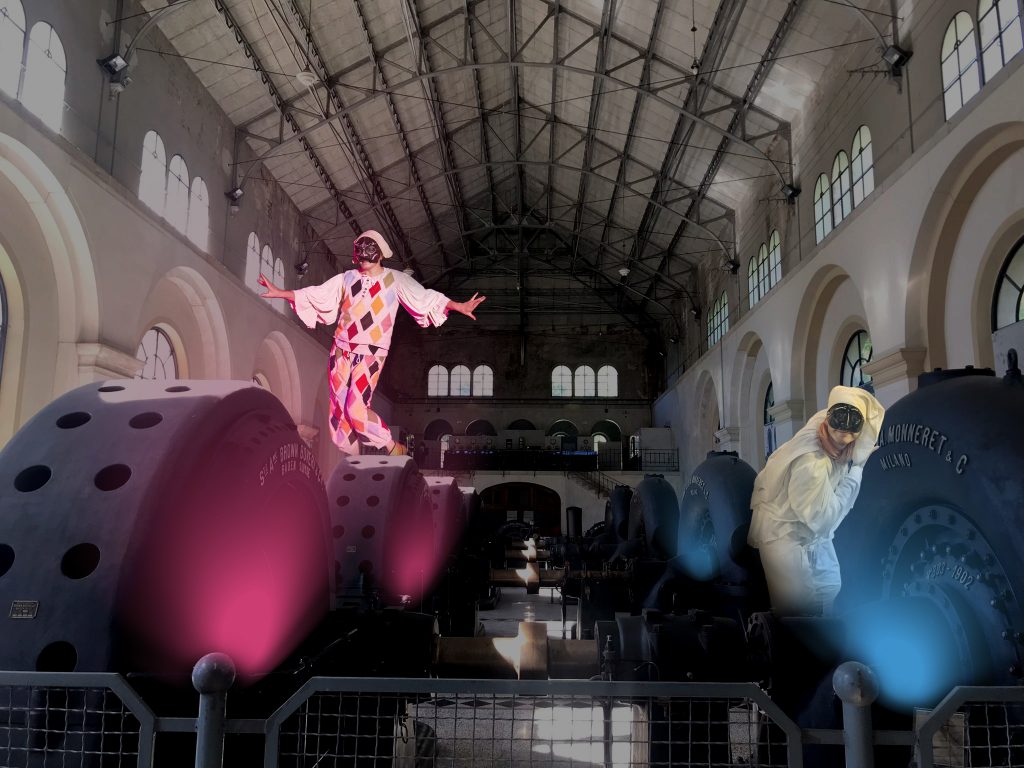
Maravee Circus 2023, Centrale idroelettrica “Antonio Pitter” – Malnisio, ph. Renato Patat
Dei tanti luoghi riattivati, ci sono esempi virtuosi che hanno poi dato il via a un processo reale di riqualificazione rigenerazione?
Innanzitutto la prima sede del Festival Maravee – Villa Ottelio-Savorgnan ad Ariis di Rivignano (UD) – che abbiamo riaperto nel 2002 su proposta della Regione Friuli Venezia Giulia. Luogo storico-naturalistico di grande fascino, con diversi stabili, gli ex Magazzini del sale e un parco sul lungofiume Stella, offriva una fantastica scenografia inutilizzata, tanto che abbiamo dovuto dotarci di un grande generatore di corrente e fino al 2008 è diventato luogo di appuntamento con un Festival che alla prima edizione ha contato in una sola sera 1.200 presenze.
Poi il Festival in ogni edizione si è esteso in più location e, in merito alla riqualificazione cito la torre del Museo CID di Torviscosa che, chiusa dagli anni ’60 quand’era lo studio di Marinotti, fondatore della SNIA Viscosa, è stata restaurata appositamente per Maravee ospitandone due edizioni e poi altri eventi.
Da Villa Ottellio Savorgan, edizione di lancio indimenticabile del Festival Maravee, il progetto è passato per luoghi simbolo come la Torre del Cid (Museo CID di Torviscosa con una mostra di Getulio Alviani durante Maravee Energy), ai Castelli storici, e oggi all’ex centrale idroelettrica di Malnisio.
Quale futuro e progettualità per questo luogo?
In questa splendida architettura industriale primonovecentesca, in cui si narra la straordinaria avventura tecnologica che ha trasformato il torrente Cellina in fonte energetica, quest’anno il Festival Maravee Circus ha individuato la metafora di un bypass energetico fra lo stato di stand by (il Clown clochard) e lo stato di accensione (il Clown Joker). E’ un concreto esempio della costruzione di uno spettacolo e di una mostra sulle peculiarità storiche e sulle originarie funzioni d’uso di una location!
Qui siamo in un contesto già riqualificato, dato che la Centrale idroelettrica “Antonio Pitter” di Malnisio è un Museo, che dipende dal Comune di Montereale Valcellina con la gestione di Eupolis. Un Museo che sottolinea la storia tecnologica di questo luogo, ma che necessita di una puntuale e lungimirante programmazione culturale di eventi. Gli spazi, sia interni sia esterni sono fantastici e stimolanti, tanto che sin dalla mia prima visita ho iniziato a pensare a diversi progetti, di mostre, spettacoli e performance itineranti. Sempre con l’intento di proporre al pubblico un viaggio esperienziale tra il passato e il presente, per riaccendere in diversi momenti dell’anno la luce che in questo luogo veniva prodotta arrivando fino alla Piazza San Marco di Venezia!

Maravee Circus 2023, Centrale idroelettrica “Antonio Pitter” – Malnisio, ph. Renato Patat
Su quali basi selezioni le location e quale il processo di scouting che ti porta a sceglierle?
Vent’anni fa la mia esplorazione di ricerca era guidata unicamente dalla bellezza e dalla potenza storico-naturalistica dei luoghi, dalle loro connessioni contenutistiche con le tematiche affrontate nei progetti e dalla potenzialità di utilizzo delle architetture e degli scenari naturali come scenografie degli eventi. Con questi criteri siamo approdati in castelli, Musei, parchi pubblici e privati, ma anche in luoghi mai sfruttati per eventi artistici, come per esempio il Parco Scientifico e Tecnologico “Luigi Danieli” nella zona industriale di Udine, che con i suoi corridoi bianchi e asettici si prestava per una mostra sulle energie rinnovabili, realizzata grazie alla collaborazione di cinque docenti dell’Università di Udine. Questi criteri, che ancora oggi animano il processo di scounting, sono poi stati affiancati da un fondamentale principio: l’approdo in ogni nuova eventuale location deve essere supportato da un contributo finanziario proveniente dalla location stessa, sia essa legata al pubblico o al privato. Perché l’assenza di questo presupposto annulla qualsiasi azione produttiva!
Ci sono degli esempi su scala internazionale che ritieni siano riusciti — utilizzando un linguaggio simile — ad avvicinare diverse fasce di pubblico all’arte e allo stesso tempo a riattivare dei luoghi e dei circuiti in disuso?
Mi viene in mente il caso di Saint-Etienne, in Francia, quale ottimo esempio di trasformazione da città industriale (alla fine del XIX secolo era conosciuta come la città delle miniere di carbone) a città verde e della cultura, che dal 2009 nel grande impianto industriale risalente al 1866 ospita la Cité du Design e la Biennale internazionale del Design nella Platine, l’enorme edificio costruito nell’area dell’ex fabbrica di armi. Una riconversione importante, che ha fatto di Saint-Etienne l’unica città francese entrata a far parte della rete Città creative del design Unesco.
Quasi tutte le edizioni del Festival Maravee sono state caratterizzate dell’intervento e dal supporto di importanti imprese del settore privato, molte legate al mondo del design. Quale il rapporto — dal tuo punto di vista — tra creatività e impresa?
Un rapporto che ritengo fondamentale proprio nella prospettiva di portare l’arte e lo spettacolo contemporanei nel quotidiano collettivamente condiviso. Un rapporto, però, che deve prendere le distanze dall’ormai anacronistica sponsorizzazione, fondata solo sul supporto paternalistico dell’impresa che sostiene economicamente la cultura. Creatività e impresa, unite alla didattica d’alta formazione e alle istituzioni pubbliche, devono relazionarsi in progettualità radicate nel principio del partenariato, con obiettivi e filosofie comuni. Solo in questo modo si può tendere a risultati soddisfacenti per tutte le parti coinvolte e quindi alla produzione di progetti d’ampio respiro.
Creatività e impresa, unite alla didattica d’alta formazione e alle istituzioni pubbliche, devono relazionarsi in progettualità radicate nel principio del partenariato, con obiettivi e filosofie comuni.
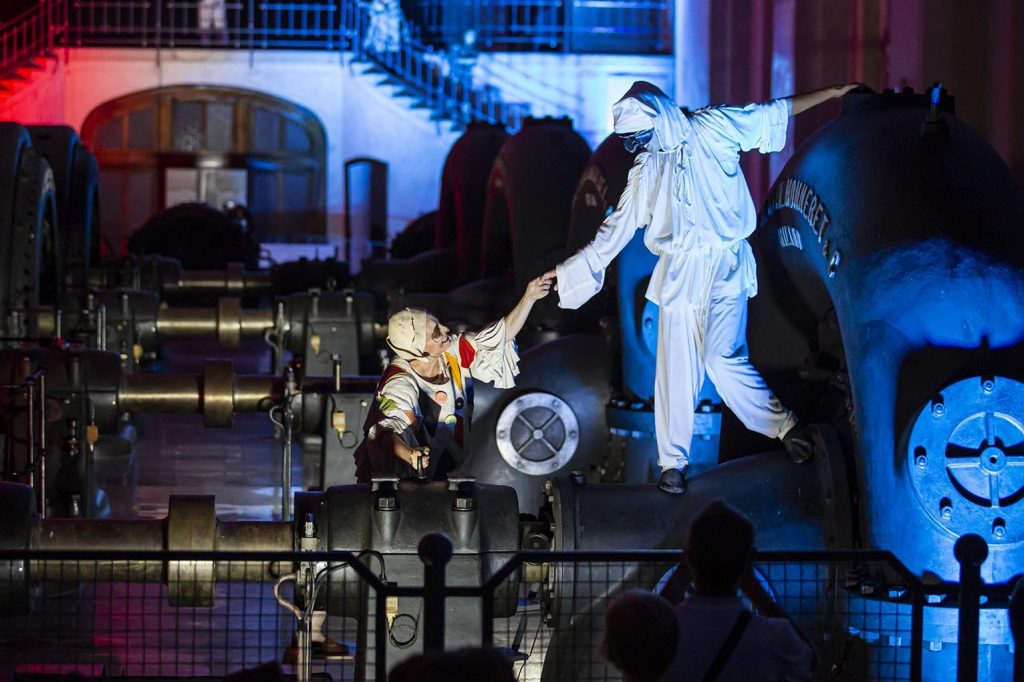
Maravee Circus 2023, Centrale idroelettrica “Antonio Pitter” – Malnisio, ph. Renato Patat
A proposito di creatività e impresa, nei prossimi mesi verranno svelati i risultati del concorso CREAttivo dedicato al mondo del mosaico.
Qualche anticipazione?
Il progetto “CREAttivo”, giunto alla sua quarta edizione e quest’anno intitolato “Arte e Impresa FVG in Cammino”, prosegue il suo corso di rigenerazione urbana costruendo nuovi Parchi ludici/interattivi votati alla vita comunitaria all’aria aperta, quindi alla sostenibilità sociale e ambientale. A fine ottobre inaugureremo il nuovo parco ad Aquileia, antica città musiva per eccellenza e per questo divenuta Città Unesco. Appellandosi agli antichi mosaici pavimentali della sua notissima Basilica, le vincitrici del Concorso Internazionale alla Scuola Mosaicisti del Friuli – l’indiana Purnima Allinger e la francese Pauline Debuchy – impreziosiranno con i mosaici contemporanei i giochi da parco dell’azienda Legnolandia e complementi d’arredo delle aziende Gervasoni e Very Wood, che verranno esposti nella mostra al Museo di Santa Chiara di Gorizia. Scelta, quest’ultima, dettata dalla volontà di sottolineare questa azione di rigenerazione urbana tra storia e contemporaneità anche nell’atteso percorso culturale che farò di Gorizia-Nova Gorica Capitale Europea della Cultura nel 2025.
In conversation with Sabrina Zannier,
curator and director of Maravee,
a twenty years long journey through former industrial areas,
historical villas, castles, private spaces
Redevelopment, regeneration, reuse and reopening of former industrial areas, private spaces, historic villas and not least castles. Places and an approach that have always characterised your work, transferred as a matrix to the many projects you have curated and directed. What is the underlying idea?
The need to bring contemporary art and entertainment into the collectively shared everyday world, because I firmly believe that cultural thought and artistic production must take on a social role devoted to welfare and that this role must be recognised across the board.
Re-animating places dense with history through performances and exhibitions conceived on social, cultural and industrial connotations, as well as on the original uses of those places, means building a conscious bridge between the past and the future. A bridge that I have always tried to animate through the versatility of artistic languages and an empathetic and engaging staging. In order to reach a wide and multi-faceted audience, the ivory tower mentality which the art world has built around itself must be debunked.
Re-animating places dense with history through performances and exhibitions conceived on social, cultural and industrial connotations, as well as on the original uses of those places, means building a conscious bridge between the past and the future.
Among many venues that have been reactivated, are there any valorous examples that have given rise to a real process of regeneration redevelopment?
First of all, the first venue of the Maravee Festival – Villa Ottelio-Savorgnan in Ariis di Rivignano (UD) – which we reopened in 2002 at the suggestion of the Friuli Venezia Giulia Region. A historical-naturalistic place of great charm, with several buildings, the former salt warehouses and a park on the Stella riverfront, it offered a fantastic unused backdrop, so much so that we had to equip ourselves with a large power generator, and until 2008 it became the venue for a Festival that counted 1,200 attendees in a single evening at the first edition.
Thus, season by season, the Festival was able to expand to more locations and, with regard to redevelopment, I would like to mention the tower of the CID Museum in Torviscosa which, closed since the 1960s when it was the studio of Marinotti, founder of SNIA Viscosa, was restored specifically for Maravee, hosting two seasons before becoming the venue for other events.
From Villa Ottellio Savorgan, the unforgettable launch event of the Maravee Festival, the project has passed through symbolic places such as the Torre del Cid (CID Museum in Torviscosa with an exhibition by Getulio Alviani during Maravee Energy), the historic Castelli, and now the former hydroelectric power station in Malnisio. What are the future and plans for this place?
In this splendid early twentieth-century industrial architecture, which narrates the extraordinary technological adventure that transformed the Cellina stream into a source of energy, this year the Maravee Circus Festival has identified the metaphor of an energy bypass between the stand-by state (the Clown Clochard) and the switched-on state (the Clown Joker). This is a concrete example of how to construct a show and exhibition based upon the historical peculiarities and original use of a location!
Here we are in a context that has already been redeveloped, since the ‘Antonio Pitter’ hydroelectric power station in Malnisio is a Museum, under the management of Eupolis for the Municipality of Montereale Valcellina. It is a museum that emphasises the technological history of this place, but one that requires a timely and far-sighted cultural programming of events. The spaces, both inside and outside, are fantastic and stimulating, so much so that from my first visit I started thinking about various projects, of exhibitions, shows and travelling performances. Always with the intention of offering to the public an experiential journey between the past and the present, to rekindle at different times of the year the light that used to be produced in this place which travelled all the way to St. Mark’s Square in Venice!
On what basis do you select locations and what is the scouting process that leads you to choose them?
Twenty years ago, my scouting exploration was guided solely by the beauty and historical-naturalistic power of the locations, their contextual link with the themes addressed in the projects, and the potential for using the architecture and natural scenery as settings for events. With these criteria, we have landed in castles, museums, public and private parks, but also in places that have never been exploited for artistic events, such as the ‘Luigi Danieli’ Science and Technology Park in the industrial area of Udine, which with its white and antiseptic corridors lent itself to an exhibition on renewable energy, realised thanks to the collaboration of five professors from the University of Udine. These criteria, which still animate the scouting process today, were then joined by a fundamental principle: the landing in any possible new location must be supported by a financial contribution from the location itself, whether public or private. Because the absence of this prerequisite nullifies any productive action!
Are there any examples on an international scale that you think have succeeded – using a similar language – in bringing different audiences closer to art and at the same time reactivating disused places and circuits?
I am reminded of the case of Saint-Etienne, France, as an excellent example of transformation from an industrial city (at the end of the 19th century it was known as the city of coal mines) to a green and cultural city, which since 2009 has been hosting the Cité du Design and the International Biennial of Design in the Platine, the huge building constructed on the site of the former arms factory, in the large industrial plant dating back to 1866. A major conversion, which has made Saint-Etienne the only French city to join the Unesco Creative Cities of Design network.
Almost all the editions of the Maravee Festival have been characterised by the intervention and support of important private sector companies, many of them linked to the world of design. What is the relationship – from your point of view – between creativity and business?
This is a relationship that I consider fundamental precisely in the perspective of bringing contemporary art and entertainment into the collectively shared everyday life. A relationship, however, that must distance itself from the now anachronistic sponsorship, based only on the paternalistic support of the enterprise that economically supports culture. Creativity and business, together with higher education and public institutions, have to relate in projects rooted in the principle of partnership, with common goals and philosophies. This is the only way to strive for satisfactory results for all parties involved and thus for the production of wide-ranging projects.
Creativity and business, together with higher education and public institutions, have to relate in projects rooted in the principle of partnership, with common goals and philosophies.
Speaking about creativity and enterprise, the results of the CREAttivo competition dedicated to the world of mosaics will be revealed in the coming months.
Any advance notice?
The ‘CREAttivo’ project, now in its fourth edition and this year entitled ‘Art and Enterprise FVG on the Way’, continues its course of urban regeneration by building new play/interactive parks devoted to community life in the open air, and thus to social and environmental sustainability. At the end of October we will inaugurate the new park in Aquileia, an ancient mosaic city par excellence and therefore a Unesco City. Appealing to the ancient floor mosaics of its famous basilica, the winners of the International Competition at the Friuli Mosaic School – Purnima Allinger from India and Pauline Debuchy from France – will embellish with contemporary mosaics the outdoor games of the company Legnolandia and interior design features of the companies Gervasoni and Very Wood, which will be displayed in the exhibition at the Museum of Santa Chiara in Gorizia. The latter is a choice dictated by the desire to emphasize this action of urban regeneration between history and contemporaneity and is also in the long-awaited cultural itinerary that will make Gorizia-Nova Gorica European Capital of Culture in 2025.

